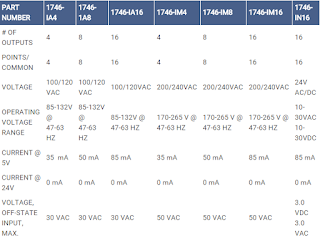The Allen-Bradley SLC 500 System is a modular, small chassis-based class of programmable controllers integrating discrete, analog, and specialty I/O and peripheral devices in stand-alone electronics cabinets.
The System has become the choice of manufacturing engineers worldwide because it is the industry standard for reliability and cost effectiveness. Consider these features that make the SLC 500 System the option you should consider:
- Powerful - the SLC 500 System offers programmable controllers that are well equipped to handle a broad range of applications from small, one machine processes to high speed assembly operations, and all points in between.
- Modular - the System can be configured to your precise needs today, yet is totally expandable and adaptable to future changes. Power supplies, memory capabilities, the number and type of input and output points, and the various communication links required are all easily included in the System to satisfy virtually every situation.
- Advanced Instruction Capability - indirect addressing, high level math capabilities, and compute instructions are a feature of the System.
- Communication versatility - options include on-board Ethernet, DH+, DH-485, ControlNet, DeviceNet, and Remote Input/Output.
- Numerous I/O Options - modules are available to fulfill every conceivable need, from both discrete and analog I/O to temperature signals to a wide array of third-party specialty modules compatible with the System.
- Industrial Use Design - the SLC 500 System is engineered to withstand the extremes encountered in industrial environments, such as excessive vibration, temperature fluctuations, and even electrical noise and interference.
- Windows Software - RSLogix 500 programming software is an Allen-Bradley/Rockwell Automation exclusive product designed to maximize productivity by simplifying program development and/or troubleshooting. The RSLogix 500 ladder logic programming includes flexible editors, point-and-click I/O configuration, and a powerful database editor.
The SLC 500 System can be configured with up to 64 K of data/program memory and literally 100s of types of both discrete and analog I/O modules, making it the system of choice for everything from very basic to extremely intricate industrial applications. Minimum SLC 500 Systems require a processor module, and I/O modules in a single chassis with a power supply. Advanced local Systems can be created, using from one to three local chassis and up to 30 I/O and/or communication modules. More complex Systems are created using I/O across networks distributed in remote locations and connected via multiple I/O links.
Creating a SLC 500 System may seem to be a daunting task at first, but it is really a very straightforward proposition. The first step is to examine the manufacturing blueprints, and all related machine and electrical functions requiring an input /output. Plot the entire operation in a spreadsheet to determine the exact number of I/O points that will be required as well as the amount of memory needed to complete the operations. Once you have determined the number of I/O points, and all specialty applications, such as temperature controllers, you are ready to select the various elements of the SLC 500. Here are some ideas on selecting the appropriate hardware, and accompanying tables identifying the various components and their capabilities.
To create an SLC 500 System there are a few basic steps to take. This week we will look at the first step, I/O Modules:
Allen Bradley SLC 500 I/O Modules
Allen-Bradley offers both discrete (digital) and analog Input and Output modules of various capabilities. The digital Input/Output modules feature a discrete signal that is either on or off, such as the input of limit switches or the output signal to a relay. Conversely, analog Input/Output modules convert voltage or current to point-in-time values via the processor, such as the input received by a thermocouple or the output signal of a pressure regulator. Virtually all SLC 500 Systems will incorporate the use of both discrete and analog Input and Output modules.
The SLC 500 System delineates between the various discrete modules by sorting them into two categories: Sinking and Sourcing. As an engineer designing your own system it will help you to understand the difference between these two options. Here is the definition as given by Allen-Bradley:
"Sinking and Sourcing are terms used to describe a current signal flow relationship between field input and output devices in a control system and their power supply.
- Field devices connected to the positive side (+V) of the field power supply are sourcing field devices.
- Field devices connected to the negative side (DC Common) of the field power supply are called sinking field devices.
To maintain electrical compatibility between field devices and the programmable controller system, this definition is extended to the input/output circuits on the discrete I/O modules.
- Sourcing I/O circuits supply (source) current to the sinking field devices.
- Sinking I/O circuits receive (sink) current from sourcing field devices.
Europe: DC sinking input and sourcing output module circuits are the commonly used options"
The following tables will help you to compare the Discrete Input/Output modules available in the Allen-Bradley SLC 500 System as well as the Analog Input/Output modules:















 Facebook
Facebook